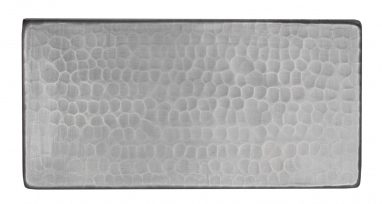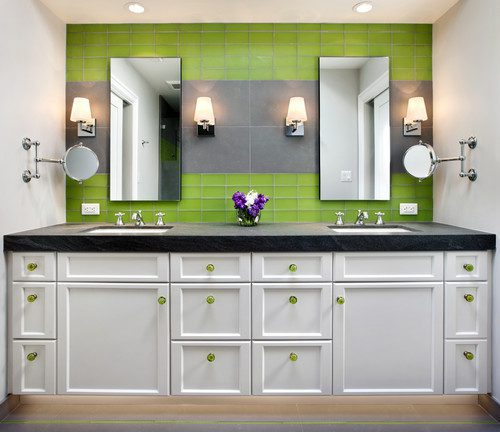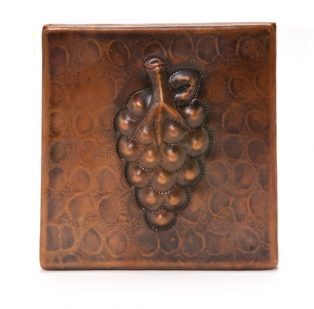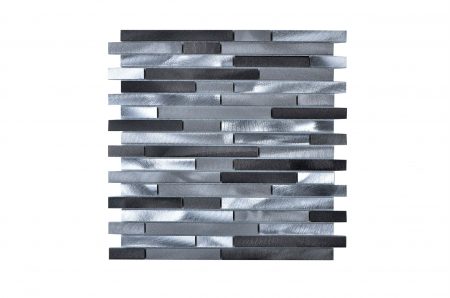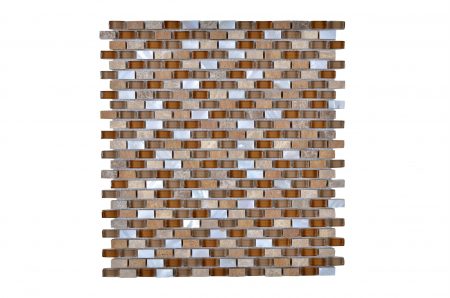Backsplashes are a great addition to any kitchen or bathroom space. Initially designed to provide extra protection for kitchen and bathroom walls, these are now a focal point of many spaces and give people the chance to create a unique finish that compliments their counters, walls, and other elements. To provide more insight and help you decide what you need, here are 10 of the most common Q&A related to bathroom backsplashes.
3 Inch Nickel Plated Hammered Copper Tile
- What Is a Backsplash?
- Do You Need a Backsplash for Your Bathroom Vanity?
- What Is the Ideal Height of a Backsplash?
- What Are Common Backsplash Materials?
- Does Your Backsplash Have to Match Your Vanity Countertop?
- Can You Use Peel-and-Stick Tiles on Bathroom Walls?
- Should You Start a Backsplash From the Top or Bottom?
- How Is a Backsplash Installed?
- How Often Should You Replace Backsplash Tile?
- Should the Backsplash Be Matte or Shiny?
What Is a Backsplash?
Essentially, a backsplash is a functional feature that serves as a vertical extension of your counters. These can be just a few inches high or they can go up the entire wall, and they’re designed primarily for function first. As the name suggests, the backsplash is designed to protect the walls from errant splashing and water damage. They can also protect against things like grease spatter during cooking when used in the kitchen. In the bathroom, they’re primarily a defense against water.
Related: 12 Questions About Farmhouse Bathroom Sinks
Photo by Bernard Andre Photography
Do You Need a Backsplash for Your Bathroom Vanity?
Many homeowners are unsure if they need to have a bathroom backsplash installed with their vanity. There are several benefits to be had from installing a bathroom backsplash. It can prevent damage to the paint and the walls behind the vanity that could be caused by water splashing. A backsplash can enhance the look of your bathroom, too, and can even help prevent the build-up of mold and mildew. Plus, they’re easy to install and have tons of options to choose from.
What Is the Ideal Height of a Backsplash?
Most people install a bathroom backsplash that is about 4 inches high. This offers protection for most walls and adds a simple design aesthetic. You can install a taller backsplash, depending on your preferences. Some people choose 8 inch backsplashes, while others choose their own height somewhere in between.
4 Inch Square Copper Grape Tile
What Are Common Backsplash Materials?
There are several different materials used for backsplashes. Usually, people will have them installed in materials that are similar to or the same as their counters. Some people will choose a different material to create a unique finish, or because they like the look of it. The most common backsplash materials include:
- Tile
- Ceramic
- Granite
- Marble
- Stone
- Glass
- Laminate
You can also find peel-and-stick tiles that work great to add a quick backsplash to a bathroom space or choose washable wallpaper, but that still leaves the walls exposed to damage.
Related: Decluttering Your Bathroom Is The Key To Redecorating
Does Your Backsplash Have to Match Your Vanity Countertop?
While matching helps create a unified look in the space, the backsplash doesn’t necessarily have to match the vanity countertop that you choose. You can also opt to install a complementary backsplash that accents your counter with a different material and finish if you’d like. Essentially, it’s about creating the look that you want, whether that means matching your vanity or going a different route.
Silver and Gray Mosaic Aluminum Tile
Can You Use Peel-and-Stick Tiles on Bathroom Walls?
Today, laminate peel-and-stick tiles are making renovations easy. They make for a quick backsplash addition and can be used in any space. If you are using these tiles on bathroom walls, make sure that the walls are clean and dry before installing them, and be sure to line them up well so they create a uniform finished look.
It’s important to note that these tiles are not as durable as actual tile materials like ceramic or stone, but they can be an affordable option when you have a bathroom where there isn’t a lot of water splashing.
Related: 2023 Design Trends To Watch For
Should You Start a Backsplash From the Top or Bottom?
Backsplashes are generally started from the bottom (the top of the counter) and then installed upwards until the preferred height is reached. This ensures that the backsplash is even with the counter and is properly sealed at the lower levels where it is more likely to encounter water splashing and other issues.
How Is a Backsplash Installed?
Installation starts by preparing the surface. If there are plain walls present, those will need to be cleaned and dried before starting the installation. If an existing backsplash is in place, it will need to be removed before the new one can be installed. Then, the backsplash is started at the counter and then tiles or other backsplash materials are installed upwards until the correct height is reached. If you are installing a stone or tile background, you will need to grout and space the tiles accordingly. This is why the installation is sometimes best left to the professionals when it comes to bathroom backsplashes.
Related: The Rise In Popularity Of Black Bathroom Vanities
How Often Should You Replace Backsplash Tile?
Backsplash tiles only need to be replaced when they are worn or damaged, or if you just decide that it’s time for a new look. Backsplashes are designed to last for decades when they are properly installed, so you shouldn’t have issues with damage and wear if you have the installation done properly.
You can replace backsplashes as a way to upgrade a kitchen or bathroom without redoing the whole room, too, so be sure to inquire about that with your installer. If the backsplash is old and in disrepair, a replacement might be the best option.
2 Inch Square Hammered Copper Tile
Should the Backsplash Be Matte or Shiny?
Backsplash materials come in two finishes: matte and shiny. Some people prefer the clean, sparkly look of shiny materials like tiles that reflect light and create a unique look in the space. Others like the idea of a matte finish that kind of mutes the backsplash and allows people to focus on other elements in the space.
Ultimately, whether you choose a matte or shiny backsplash will depend on the materials you desire, the look you’re going for, and other preferences. There is no right or wrong answer here—it’s all about your preferences.
There you have it—10 of the most pressing questions about bathroom and kitchen backsplashes and what they can do for your space. Now that you’re more familiar with these unique accents, you should take the time to find inspiration online to help you decide on your bathroom design and what type of backsplash you want for your space.
Related: 10 Questions About Bathroom Sink Faucets

